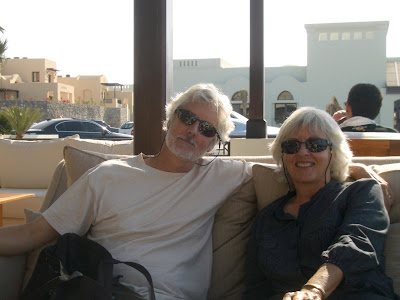Fortunately, non-Emiratis are not expected to adopt this mode of dress; in fact it's discouraged. However, foreign women with bare arms and legs and low necklines are frowned upon, and unlikely to receive prompt service in offices and shops. Sarah Jane and I carried shawls with us to cover our arms when we were not in the car or in one of the resort hotels where a cruise-ship atmosphere and skimpy clothing was the norm. We stopped for a drink in one of these resorts, pausing to admire the Maserati parked in the forecourt,

before settling on the terrace with a view over the swimming pool to the sea.



RAK is developing so fast that the terrain is littered with new mansions for the newly rich, most of them sitting starkly on the desert floor, surrounded by high walls to protect the female occupants from the view of passers-by.

Near the houses above, we saw many shrubs with soft, grey leaves and small but beautiful purple and white flowers. Thanks to my daughter's colleague, Barbara, I now know these to be Calotropis procera, also known as Giant Milkweed.


Here's a good description of its habits and uses from an internet site:
Originally from warm parts of Africa and Asia, this is now pantropical and in ecological terms is regarded as an indicator of overgrazed land. I have seen it growing extensively in Oman (Arabia), being one of the few plants that goats and camels won't eat, and also in Antigua, in habitats degraded first by sugar cane cultivation and now by cattle and goats.
There are no doubt many other places in the world where giant milkweed abounds. It may be common and widespread but it is a magnificent shrub, reaching 10 feet tall, with large silver-green leaves, clusters of waxy purple-tipped flowers, and inflated pale green seed pods. The pods split open when ripe to release silk-tufted seed to the wind. The latex is poisonous, containing digitalis-like compounds that affect the heart, and is used to make arrow poison. Medicinally, the acrid sap latex is used to treat boils, infected wounds and other skin problems in people, and to treat parasitic skin infestations in animals. It also yields ash for making gunpowder, and extremely strong fiber.
– Deni Bown, Promising Plants Presentation, 2003
No comments:
Post a Comment